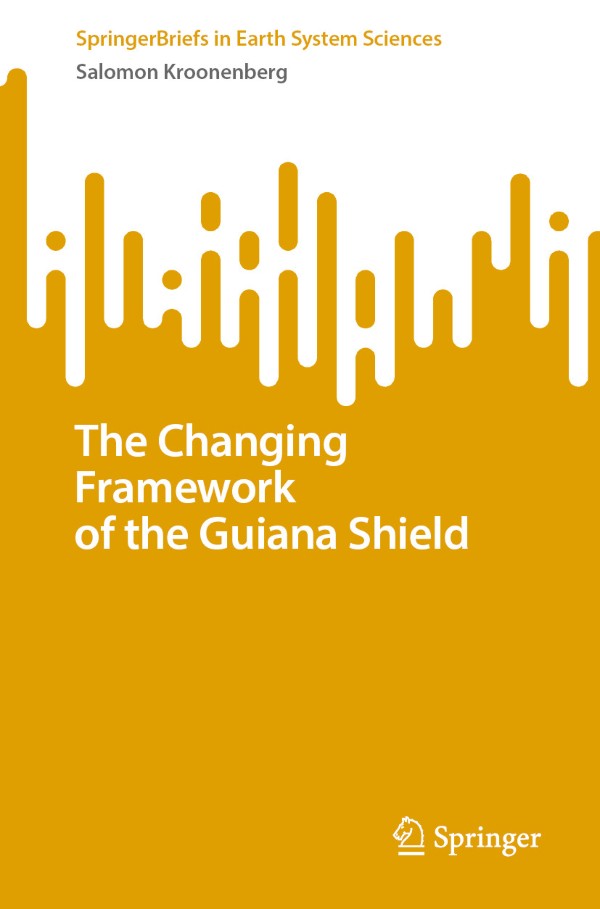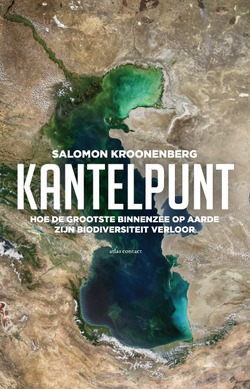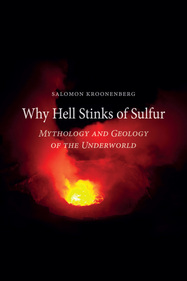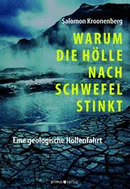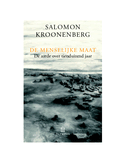Media
Books
I have always been fascinated by geological time. From the time I was walking around on two billion years old rocks in Surinam, and saw the whole geological history reflected in the wide landscapes of the Colombian Andes, I cannot resist the thought that we human beings, with a history of mere 150,000 years, are only newly born babies for the Earth. We are just the skin of paint on the pinnacle-knob of the Eiffeltower, as Mark Twain puts it. We have experienced near to nothing of what the Earth is capable of.
Yet we behave as if we are the masters, the proprietors, the caretakers of the Earth; as if our ecological footstep is so huge that it tends to destroy the Earth. It is a sad, narrowly anthropocentric view. The Earth couldn’t care less. All disasters mankind is afraid of have already occurred in the geological past: carbon dioxide levels ten times as high as at present during a Greenhouse Earth without any ice caps at all; sea level 200 m above and 120 m below the present level, volcanic eruption beyond any human imagination. Our footstep is wiped off the wet beach at the next high tide.
That is the main theme of my first book The human scale – the Earth in 10,000 years from now. I look at earthquakes, volcanic eruptions, climate change, sea-level, river behaviour and evolution, starting each time on the human, daily scale, and then proceeding to ever increasing scales of time and space. I think it is relevant to consider longer time scales in all aspects of daily life. If we can consider the effect of storage of nuclear waste in 10 000 years from now, why not do the same for climate? The book was awarded the Eureka prize for the best popular science book in 2007.
My second book Why hell stinks of sulfur - Mythology and geology of the underworld is an account of my voyage to the centre of the Earth, in the footsteps of Homer, Virgil, Dante, Leonardo da Vinci, Descartes, Jules Verne, and modern science. I want to see with the eyes of a geologist, armed with hammer and compass, what hell consists of, where the sulfur and the tar come from, how much fantasy people needed to understand what’s inside the earth, and how much fantasy we need even now to that end. We have travelled to the moon, but not to the centre of the Earth, which is not farther away than Washington from Paris. The Earth should not be seen as a supermarket for human needs, as a black box to dig tunnels through, or as an easy receptacle for dead bodies and human waste. The Earth is an immensely rich archive, it is its own history book, and any hole we dig in it destroys a part of that history. Moreover it is a unique ecosystem, the wealth of which we have only just started to fathom. The book was longlisted for the Bob den Uyl prize for literary travels.
Tipping point is the English translation of my Dutch-language book Kantelpunt. It describes how in the Cenozoic history of the Caspian Sea at least four dramatic events completely wiped out the existing mollusc biodiversity, and laid the ground fornew generations of organisms that had to cope with radically different environmental conditions as previous generations. The book follows the discoveries made by 15 young scientists from all over the world, each in their own disciplines, but all contributing to an overall picture of how tectonics, sea-level change, climatic oscillations and human interference shaped the fascinating history of the earth’s largest closed water basin.
My only original English-language book The changing framework of the Guiana Shield (2025) summarizes the history of scientific research of one of the oldest portions of the Earth’s crust, the Guiana Shield, my preferred geological hunting ground in the over 50 years of my career in the earth sciences.
The Changing Framework of the Guiana Shield (2025)
This book describes the widely different concepts that have been developed about the general structure and origin of the Guiana shield during the last one hundred years. A review of the evolution of thoughts about the geological framework of the Guiana Shield shows that many problems discussed at present have deep roots in the past: is the shield essentially an Archean craton reworked and remobilized by later Proterozoic events, or is it the result of juvenile continental accretion around pre-existing Archean nuclei? Is the tectonic development comparable to that in the Archean or to modern orogenic processes, and what is the role of plate tectonics? All these questions have an immediate bearing on metallogenesis in the shield.
On the basis of many published maps and stratigraphic schemes, advances in geochronology, geochemistry and structural geology, this book shows that many problems have still to be solved. It is based on thorough literature research, including many 'grey' papers in old conference proceedings that are not available digitally, written in the five languages of the Guiana Shield countries Dutch, English, French, Portuguese and Spanish, collected by the author during the fifty years of his involvement in Guiana Shield research.
One of the striking features is that from the beginning until the present day, there are discrepancies between the views of scientists from the northern Guianian countries Colombia, Venezuela, Guyana, Suriname and French Guiana on the one hand, and the views of many Brazilian scientists in the south on the other hand, both sides commonly ignoring or neglecting the knowledge obtained by the other side across the rainforest-clad divide. Only a recent international cooperation programme opened the dialogue. By bringing together these views, the book contributes to a better understanding of the history of the Guiana Shield.
Tipping point: How the largest inland sea on earth lost its
biodiversity (2019)
When Dutch biologist Frank Wesselingh studied sediment cores from the southern
Caspian Sea in Azerbaijan, he was dismayed to discover that all original mollusc
species had disappeared in the twentieth century and replaced by alien one. The
Caspian Sea is a closed basin and its brackish waterecosystem is just as unique
as Australia's land-based ecosystem.Accidental introduction of alien mussel species
attached to ships from the Mediterranean through the Wolga-Don and other canals
replaced the original fauna. Other molluscs were intentionally introduced as better
food sources for the six threatened sturgeonspecies. Wesselinghassembled a team of
specialists and young scientists from more that twenty countries in the framework
of a programme funded by the European Union to study the causes and consequences
of this environmental disaster. This book tells the story of their discoveries.
It is also a personal narrative of the author on his 25 years of research in the area.
Geologists and paleontologists in the team went back intothe fossil record to study how the original fauna had evolved. At the same time geneticists studied the molecular clocks of living specimens to reconstruct the pedigree of the vanishing species. It appeared that at least four of such crises have occurred in the past fifteen million years. Plate tectonics, sea level fluctuations, climate change and ice ages caused alternating periods of isolation of the Caspian Sea and reconnection to the neighbouring Black Sea and Mediterranean, and even to the Arctic sea. Each sea-level lowstand led to freshening of the sea water by river inflow and finally desiccation and virtual extinction of the extant species. Each sea-level highstand opened the way for the introduction and evolution of a whole range of new species, not only molluscs, but also sturgeons, seals and dolphins. The history of the Caspian is one of continuing tipping points of creation and destruction of habitats by natural processes.
So what makes the twentieth century crisis different from the previous ones? Of course in the first place that it was caused by man. Conservation programs are in progress to protect threatened species from extinction and save vulnerable ecosystems. Yet the turbulent history of the Caspian poses the question: do we want to restore nature to its 'original state'? Do we want to reestablish 'nature in equilibrium'? Isn't this an anti-Darwinistic thought?There is no 'original state'. The origin of species is a matter of change in nature, notof equilibrium. Conservationists should address such dilemmas, and this book shows there is no better place to do this than the Caspian Sea. Nature is what you get if you don't interfere. All the rest is just gardening.
Why Hell Stinks of Sulphur: Mythology and Geology of the Underworld
We know almost everything about the exterior of the earth, but for most people its
interior is completely unknown. Beneath us, stretching for a distance comparable to
that between Paris and New York, lies an underground realm associated with darkness
and death. It has inspired writers and artists since time immemorial; when trying to
imagine hell, they have usually located it under the ground.
Subterranean mythology is geologist Salomon Kroonenberg’s point of departure. With Dante’s Inferno to hand, he takes the reader on a journey in the footsteps of Homer, Virgil, Da Vinci, Descartes and Jules Verne. Along the way he turns a scientific spotlight on the background to myths of the underworld. At a small lake near Naples he searches for the gates of hell, as described in Virgil’s Aeneid. Kroonenberg’s vast reserves of knowledge and his expressive prose allow him to transform even inconspicuous features of the landscape into fascinating sites.
Reviews: NLPVF, Reaction Book, Times Higher Education, Publishers Weekly, Inside Higher Ed, Maclean's, LA Review of Books, The Times
Reviews in german: Primus Verlag, Welt Online, Media Mania
The Human Scale: The Earth Ten Thousand Years from Now
The Human Scale sparkles with erudite iconoclasm. Salomon Kroonenberg tackles such explosive issues as climate change, the greenhouse effect and rising sea levels both unconventionally and incisively. His tone and line of reasoning demonstrate his aversion to doom-mongering; in fact he fires a formidable salvo of arguments at fashionable alarmist forecasts that suggest the earth is heading for man-made catastrophe.
Kroonenberg takes the reader around the globe from the Caspian Sea (with its extreme changes in surface level) to the Columbian volcano Nevado del Ruiz, which spewed tons of mud over the small town of Armero in 1985, turning it into a necropolis. At the same time he produces chains of facts and correlations, which he binds together into a kind of geological Theory of Everything. He offers a surprisingly new and topical perspective by forcing the reader to look over the edge of a vast abyss of time, measured in billions of years.
The Chinese translation has got a prize from the influential literary journal China Weekly Reading, and is recommended by the Chinese National Library as the best Non-fiction book of 2012.
Reviews: NLPVF, Süddeutsche Zeitung (german), Letterenfonds
Articles
- ЗЕМЛЯ в масштабе тысячелетий, The earth on a time scale of 10000 years. (russian), Ecolife Journal, 88, 3, 11-15, Moskou, December, 2009
- Erfolg nur im Sommer, scheitern im Winter? (german), Kölner Stadtanzeiger, December 18, 2009
- Catastrofismo o realismo climático (spanish), Elmundo.com, March 9, 2011
- El hombre: Un suspiro en el tiempo del mundo (spanish), El Colombiano, March 9, 2011
- There is nothing wrong with our climate, Resource, Wageningen University, May 26, 2011
Interviews
- Die Welt Online (Germany) - Deiche bauen statt Treibhausgase reduzieren - welt.de, June 6, 2008
- Argumenty i Fakty Magazine (Russia) - Грозит ли нашей планете глобальное похолодание?, Does global cooling threaten our planet? (russian), aif.ru, November, 2008
- El Colombiano - El clima no puede ser un pretexto - Lilliana Vélez de Restrepo, elcolombiano.com, Februari 18, 2011
- El Mundo (Columbia) - Kroonenberg desafía la teoría del cambio climático - Luis Fernando Múnera López, elmundo.com, Februari 18, 2011
- Delft Outlook - I don't need power, but I do want influence - Jos Wassink, TU Delft, March 2011.
- China Daily - Climate relativist challenges the new orthodoxy - Chitralekha Basu, chinadaily.com.cn, September 9, 2011.
- La Región - Salomón Kroonenberg, el geólogo holandés de Pena Corneira, Ourense (Spain), La Región S.A., 2018
Video
 |
Lecture: Cambio climático. Provocaciones de un geólogo (90 min.)
Parque Explora, 2011 |
 |
Documentary: The rising Caspian Sea (22 min.)
Yo Yo Films, 1995 |
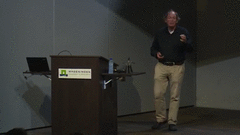 |
Lecture: WURtalk #1 - The sea-level history of human kind (23 min.)
Wageningen University, 28 september 2016 |



